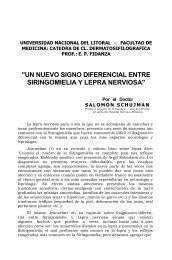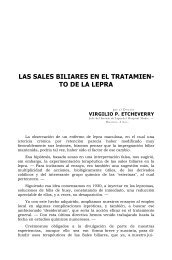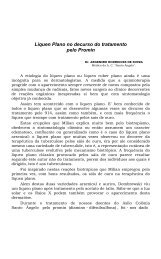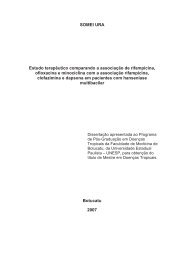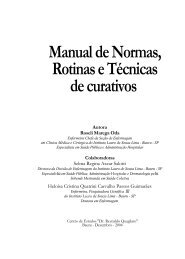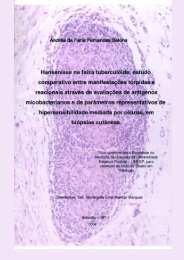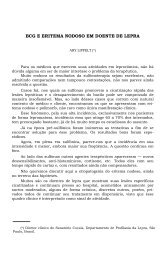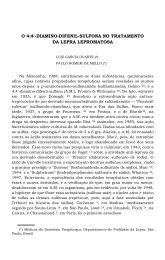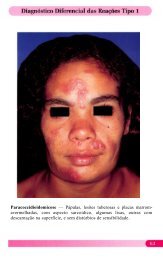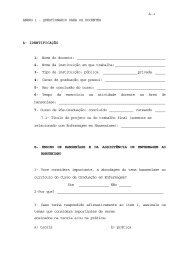EDITORIALS - Index of
EDITORIALS - Index of
EDITORIALS - Index of
You also want an ePaper? Increase the reach of your titles
YUMPU automatically turns print PDFs into web optimized ePapers that Google loves.
48, 3 ^ Editorials ^ 313<br />
b. Arthropods that feed on blood. Untreated<br />
borderline or lepromatous leprosy<br />
patients have an acid-fast bacillemia <strong>of</strong> 5000<br />
to 500,000 viable bacilli per m1 1 '. Nevertheless,<br />
the possible resulting transfer <strong>of</strong><br />
pathogens via the blood feed <strong>of</strong> an arthropod<br />
remains quantitatively small compared<br />
to the number <strong>of</strong> organisms released by the<br />
nasal route. Homogenates <strong>of</strong> laboratory<br />
bred mosquitoes (C/r/ex fiiti,i,q/oN) and bedbugs<br />
(Cimex hemipteras) previously allowed<br />
to feed freely on lepromatous leprosy<br />
patients <strong>of</strong>ten contained leprosy<br />
bacilli, as confirmed by mouse foot pad<br />
studies. Some remained viable up to 48 hr<br />
after the blood meal. But the number <strong>of</strong><br />
bacilli in both instances was small''. Furthermore,<br />
the frequency with which acidfast<br />
bacilli occurred in homogenates <strong>of</strong> such<br />
arthropods from homes with an open lepromatous<br />
case did not differ from those <strong>of</strong><br />
random collections. In both, the frequency<br />
was small .'").<br />
c. Diptera. Studies have been made on<br />
the housefly (Alusca), the bluebottle (Calliphora),<br />
and the biting stable fly (Stomoxys).<br />
These were allowed to feed on lepromatous<br />
nasal secretions or ulcerated skin<br />
lesions. Pooled homogenates <strong>of</strong> legs,<br />
mouthpieces, abdominal wall, and stomach<br />
were all heavily infected one hr after feeding.<br />
A small proportion had diminishing<br />
numbers <strong>of</strong> bacilli up to three days later.<br />
The flies showed a predilection for nasal<br />
secretions and were demonstrated to be capable<br />
<strong>of</strong> infecting surfaces upon which they<br />
subsequently fed 2". Further work will he<br />
necessary to assess the extent to which flies<br />
may thus contribute to the level <strong>of</strong> environmental<br />
infection. In some parts <strong>of</strong> the world<br />
(Fig. 3) they might play a significant role in<br />
at least the mechanical transport <strong>of</strong> pathogenic<br />
organisms, including M. leprac.<br />
d) Other possible environmental sources.<br />
Large numbers <strong>of</strong> acid-fast bacilli not culturable<br />
on standard mycobacterial media<br />
2 ' Shankara Manja, K. Demonstration <strong>of</strong> Mycobacterium<br />
leproe and its viability in the peripheral blood<br />
<strong>of</strong> leprosy patients. Lepr. Rev. 43 (1972) 181-187.<br />
2" Narayanan, E., Manja, K. S. and Kirchhcimer,<br />
W. F. Occurrence <strong>of</strong> Mycobacterium leprue in arthropods.<br />
Lepr. Rev. 43 (1972) 194-198.<br />
Geater, J. G. The fly as a potential vector in the<br />
transmission <strong>of</strong> leprosy. Lepr. Rev. 46 (1975) 279-286.<br />
FIG. 3. " '.11u.s . ca Norben.■ is completely ignored by<br />
the Masai, but is the principal vector <strong>of</strong> certain eye<br />
disease infections.• Reproduced with permission from<br />
Insects and Other Arthropods <strong>of</strong> .1/edica/ importance.<br />
Smith, K. V. 0., ed. London: 'Trustees <strong>of</strong> the British<br />
Museum (Natural History), 1973.<br />
were found in skin lesions, nerve, lymph<br />
nodes, skin, and liver <strong>of</strong> seven armadillos<br />
captured from the wild (Walsh, G. P., et<br />
al. personal communication, 1976). This<br />
could reflect indigenous infection in such<br />
animals, suggesting a non-human source <strong>of</strong><br />
leprosy bacilli. However, definite conclusions<br />
concerning leprosy bacilli originating<br />
from or lodging in animals are probably premature.<br />
Finally, there is anecdotal evidence<br />
that leprosy bacilli may be harbored<br />
in plants"•". (See also the recent work <strong>of</strong><br />
Kazda, et al. Int. J. Lepr. 48 [19801 1-6,<br />
who report noncultivable acid-fast bacilli<br />
in sphagnum and moss vegetation from the<br />
former leprosy endemic areas <strong>of</strong> Norway<br />
and that these bacilli multiply like Al. Leprae<br />
in mouse foot pads.—RCH)<br />
Discussion. There is a lack <strong>of</strong> evidence<br />
bearing on this aspect <strong>of</strong> leprosy transmission.<br />
Various mechanisms such as dust,<br />
droplets, and flies could be involved, but<br />
their relative importance is unknown. Perhaps<br />
further insight may be gained by an<br />
epidemiological approach (see below).<br />
Barker, D. J. P., Clancey• J. K., Morrow, R. H.<br />
and Rao, S. Transmission <strong>of</strong> Buruli Disease. Brit.<br />
Med. J. 4 (1970) 558.<br />
" Temine, P. and Privat, Y. A case <strong>of</strong> leprosy apparently<br />
contracted in France. Ann. Med. Nancy 157<br />
(1973) 444-445.





